Abstract
Stuttering is a disorder of fluency, occurring in both children and adults. It prevents free and smooth transition from one articulation to another, and to maintain an appropriate pace, rhythm and intonation of speech. Pathological stuttering is accompanied by physiological symptoms, often combined with co-movements of the body, face, hyperactivity and spasticity. Emotionally it affects communication and social language. Inability to speak liquid leads to tension and stress of speaking. In problems of medical diagnosis, including planning and monitoring the therapy and rehabilitation of voice organs or speech-related organs, it is necessary to evaluate the qualitative features of the acoustic signal of deformed speech.
1. Introduction
Stuttering is a disorder of fluency. This disorder is caused by, among other things spasticity respiratory muscle movement, phonation and articulation and the lack of proper coordination, or incoordination of the entire respiratory and articulatory, producing, among others, muscle spasms of the larynx, leading to blocking, jamming, repetition, prolonging phonation: individual sounds, syllables, words and whole phrases [1]. They are classified as clonic stuttering, or the repetition of these sounds, syllables, words or phrases, or as a tonic blocking, which is the inability to notice the sound, desire, and at the same time the impossibility of extraction speak. It is a aphonia lasting several or even several seconds, lasts as long as the patient is struggling with muscle tensions. Pathological stuttering is accompanied by physiological symptoms, often combined with body movements, facial, hyperactivity and spasticity, emotional influencing language and social communication, where the inability to smooth the notice will lead to tension and stress associated with speaking up and logophobia.
Speech disorders in people who stutter, take the form of a many-faceted and are classified as [2]:
- clonic stuttering, or multiple involuntary repetition of individual sounds, syllables, words or phrases on a given amount of music with a noticeable increase in tension;
- tonic stuttering, characterized by a strong tension while simultaneously increasing the thrust sound stopped a musical tone and forcefulness pushing sound through the tense muscles of the larynx, at the height of the music;
- blocks that make it difficult to speak blocking, inability to extract a sound, combined with the accompanying tense pause;
- embolofazje (inappropriate sounds laryngeal) is a disorder that manifests itself as meddling these sounds laryngeal;
- dragging is unnatural sounds dragging on one tone, without being able to speak freely in the right duration the phone, reveals a longer lasting during articulation.
There are many other deficiencies such that speech stutterers, is chanted with a large dysrhythmia, flat, laryngeal, confusing fast-paced, which can be felt as soon as possible ejection from the desire to force myself shortest to pronounce and creating speech.
2. Research methodology
The study included 8 people who stutter: 3 women and 5 men aged 12 to 50 years, including a boy aged 12, a girl under 14 years and other adults who themselves came to the therapy due to the lack of freedom of speech and big problems with communication. Registration time acoustic signal waveform of speech (the text read) and EGG signal was performed in an anechoic chamber Department of Mechanics and Vibroacoustics, AGH University of Science and Technology. These signals were recorded simultaneously and stored in WAV format. Voice recording took place with a high quality measurement microphone (0.5'' G.R.A.S type 40 AF) connected by amplifier (G.R.A.S Type 12AA) with a sound card (ProFire 610) and computer a PC. Acoustic system ensures the registration signal in the band from 20 Hz to 20 kHz with the growth of not less than 80 dB. EGG signal registration is executed using a model 6103 Electroglottograph, company KAYELEMETRICS Inc. USA shown in Fig. 3. Electroglottographic (ECG) is a noninvasive method for measuring the vibration of the vocal folds, it consists of measuring the electrical impedance between two electrodes placed on the subject’s neck, at the level of the larynx. Figure 1 shows how to install the electrodes on the patient’s neck [3].
Fig. 1Measuring electrodes
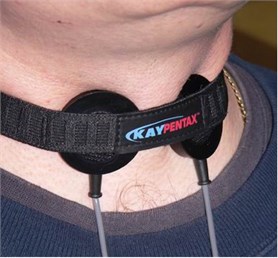
Electroglottographic does not specify the movement of each fold separately, but allows compared with other methods to a more accurate representation of the phases of opening and closing of the vocal cords, in particular vertically, which makes it possible to directly measure the progress and to determine the basic tone [5, 6]. Example registered sample signals: acoustic and EGG, while dragging phones and the subsequent clonic stuttering repeat the same sound shown in Figure 2.
Fig. 2Temporary acoustic signal waveforms (upper) and EGG (bottom graph)
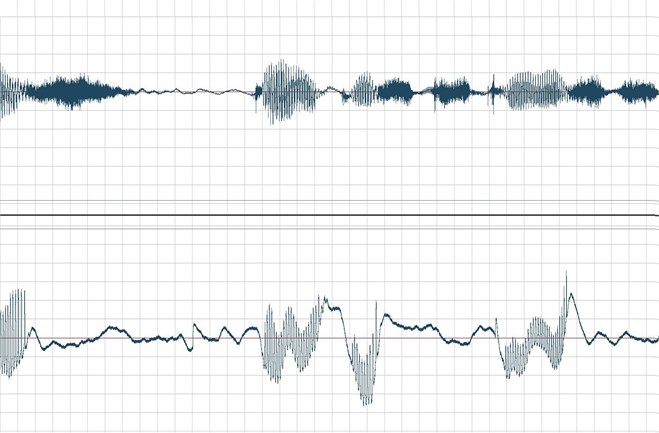
3. Results of research
In the first stage of the research carried segmentation time signals recorded into sections corresponding to the selected types of stuttering. Examples of the sample after segmentation are shown in the following Figures 3 and 4.
Fig. 3Temporary acoustic signal waveforms (upper) and EGG (bottom graph), stuttering clonic
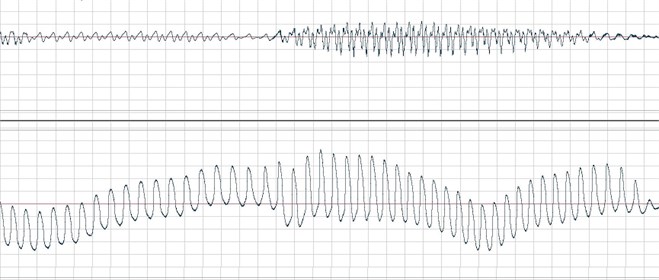
Fig. 4Temporary acoustic signal waveforms (upper) and EGG (bottom graph), stuttering – embolofrazja

Figure 5 shows a spectral analysis of the acoustic signal and EGG for stuttering clonic.
Fig. 5The spectrum of acoustic signal (a) and EEG (b), stuttering – clonic
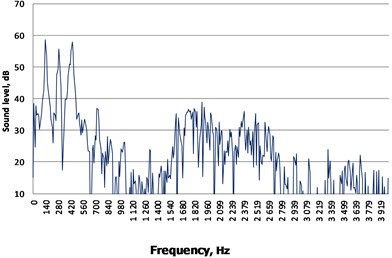
a)
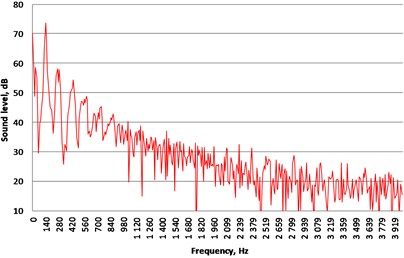
b)
The clonic stuttering EEG signal includes a distinctive harmonic at 139 Hz band on the background noise components (Figure 6). Stuttering speech signal clonic contains clear harmonics in the low frequency range (frequencies of 150, 290 and 440 Hz).
4. Conclusions
The authors are recommended to see the recent issue of the journal and prepare the manuscript in the due style. The authors are responsible for the correctness of the English language. In contrast, frequency analysis filed additional information about working vocal cords in the different types of stuttering. On the basis of these studies, which should be regarded as preliminary, it can be concluded that the parameters that will allow a more accurate assessment, as well as cognitive task stuttering process must be sought in parameters from the exact delimitation of the basic tone. Methods for determining the basic tone, the authors presented in earlier publications
References
-
Tadeusiewicz R. The Speech Signal. WKiŁ, Warszawa, 1988, (in Polish).
-
Nyka W. Ocena Ryzyka, Funkcji Motorycznych i Sprawności Ogólnej u Pacjentów z Afatycznym Zaburzeniem Mowy w Ostrym Okresie Udaru Niedokrwiennego Mózgu. Dissertation Thesis, Gdańsk, 2001, (in Polish).
-
Wszołek W., Kłaczyński M. Comparative study of the selected methods of laryngeal tone determination. Archives of Acoustics, Vol. 31, Issue 4, 2006, p. 219-226.
-
Marasek K. Electroglottography Description of Voice Quality. Phonetic AIMS, University of Stuttgard, 1997.
-
Merrilyn L. Gow, Roger J. Ingham Modifying electroglottograph-identified intervals of phonation: the effect on stuttering University of California, Santa Barbara. Journal of Speech Language and Hearing Research, Vol. 35, 1992, p. 495-511.
-
Pawłowski Z. Foniatryczna Diagnostyka Wykonawstwa Emisji Głosu Śpiewaczego i Mówionego. Publishing House „Impuls”, Krakow, 2005, p. 11-14, (in Polish).
